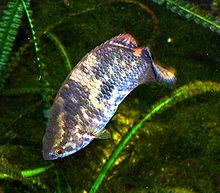Labyrinth fish
| Labyrinth fish | ||||||||||||
|---|---|---|---|---|---|---|---|---|---|---|---|---|

Mosaic Gourami |
||||||||||||
| Systematics | ||||||||||||
|
||||||||||||
| Scientific name | ||||||||||||
| Anabantoidi | ||||||||||||
| Cuvier & Valenciennes , 1831 |
Labyrinth fish (Anabantoidei), also called climbing fish , are a suborder of the Anabantiformes , which in addition to the gills also have the labyrinth organ , with which they can breathe atmospheric oxygen . They come from Asia and Africa . Because of their rich colors, some species are very popular with aquarists .
Characteristics and behavior
Due to their ability to absorb atmospheric oxygen, labyrinth fish survive in oxygen-poor water, such as warm or slow-flowing to stagnant water. The extent to which such extreme conditions also occur in natural habitats varies from species to species. Some species survive z. B. the dry season in corresponding ponds, while others live in rivers all year round.
Almost all species of labyrinth fish practice brood care and only very few are free spawners . Most of the best known build foam nests for brood care , others are mouthbrooders . As a result, they show a more or less pronounced territorial behavior. To reproduce, it is typical for labyrinth fish that the male wraps around the female more or less tightly.
Most labyrinth fish are carnivorous coarse fish . That is, they feed on zooplankton such as insects , insect larvae or small crustaceans . There are also omnivores ( giant gouramis and kissing gourami ) and predatory fish ( pike heads and some bush fish ).
Faunal history
Only a few fossil finds are known of labyrinth fish . However, they document the occurrence of representatives of this family as early as the Pleistocene ( Java ) and early Tertiary ( Sumatra ).
Labyrinth fish have a very disjoint distribution area with one distribution area in Africa and a second in Southeast Asia . This suggests that this species has existed at least since the early Middle Ages and therefore even before the disintegration of the land connection. The labyrinth fish found in Southeast Asia are characterized by a richer variety of shapes than the African ones. However, it cannot necessarily be concluded from this that today's Asian distribution area was settled from Africa.
Economical meaning
Some types of threadfish as well as the Siamese fighting fish are freshwater ornamental fish and belong to the standard range of pet shops. These species are bred on a large scale, including in Southeast Asia. There are now numerous cultivated forms of them.
In Southeast Asia, on the other hand, large species such as the giant gouramis and the kissing gourami , but also medium-sized species such as representatives of the genera Trichogaster and Anabas, are valued and kept as food fish .
Systematics

The labyrinth fish divide into three families, with only the family Osphronemidae being divided into subfamilies, of which four. The genera with the most species are the fighting fish ( Betta ) and licorice gouramis ( Parosphromenus ). There are numerous species of both genera that are only endemic to z. B. one or a few islands of the Malay Archipelago occur. The most recently known species were only discovered in the last few years and some are still undescribed.
The snakehead fish , sea bass and blue perch are considered to be the closest relatives .
Familys
- Climbing u. Bushfish (Anabantidae)
- Kissing Guramis (Helostomatidae) ( monotypical )
- Osphronemidae (all others, including threadfish, fighting fish , etc.)
Phylogeny
The following diagram shows the relationships between the three families and the subfamilies of the Osphronemidae. Of the four subfamilies of the Osphronemidae, the non- monophyletic Luciocephalinae, which split into two clades, the threadfish and a group whose eggs have a spiral structure on the surface, which probably serves as a guide system for the sperm, are missing .
| Labyrinth fish (Anabantoidei) |
|
||||||||||||||||||||||||||||||||||||
|
|
literature
- Michael Kokoschka: Labyrinth Fish. Ulmer Verlag, Stuttgart 1998, ISBN 3-8001-7431-6 .
- Horst Linke: Labyrinth fish - color in the aquarium. Tetra Verlag, Münster 1998, ISBN 3-89745-120-4 .
- Helmut Pinter: Labyrinth fish, pike heads and snakehead fish. Ulmer Verlag, Stuttgart 1984, ISBN 3-8001-7093-0 .
- Lukas Rüber, Ralf Britz, Rafael Zardoya: Molecular Phylogenetics and Evolutionary Diversification of Labyrinth Fishes (Perciformes: Anabantoidei). In: Syst. Biol. 55 (3) 2006, pp. 374-397. ISSN 1063-5157 doi : 10.1080 / 10635150500541664
- Jörg Vierke: Labyrinth fish and related species. Pfriem Verlag, Wuppertal-Elberfeld 1978, ISBN 3-921677-08-4 .
- Jörg Vierke: Labyrinth fish. Kosmos Verlag, Stuttgart 2001, ISBN 3-440-08248-2 .
Individual evidence
- ↑ Xia Li, Prachya Musikasinthorn and Yoshinori Kumazawa (2002): Molecular phylogenetic analyzes of snakeheads (Perciformes: Channidae) using mitochondrial DNA sequences. Ichthyological Research, Volume 53, Number 2 (2006), 148-159, doi : 10.1007 / s10228-005-0321-3
- ↑ Lukas Rüber, Ralf Britz, Rafael Zardoya: Molecular Phylogenetics and Evolutionary Diversification of Labyrinth Fishes (Perciformes: Anabantoidei). In: Syst. Biol. 55 (3) 2006, pp. 374-397. ISSN 1063-5157 doi : 10.1080 / 10635150500541664
Web links
- International Labyrinth Fish Community
- Detailed observations on various aspects on the website of the author Jörg Vierke.